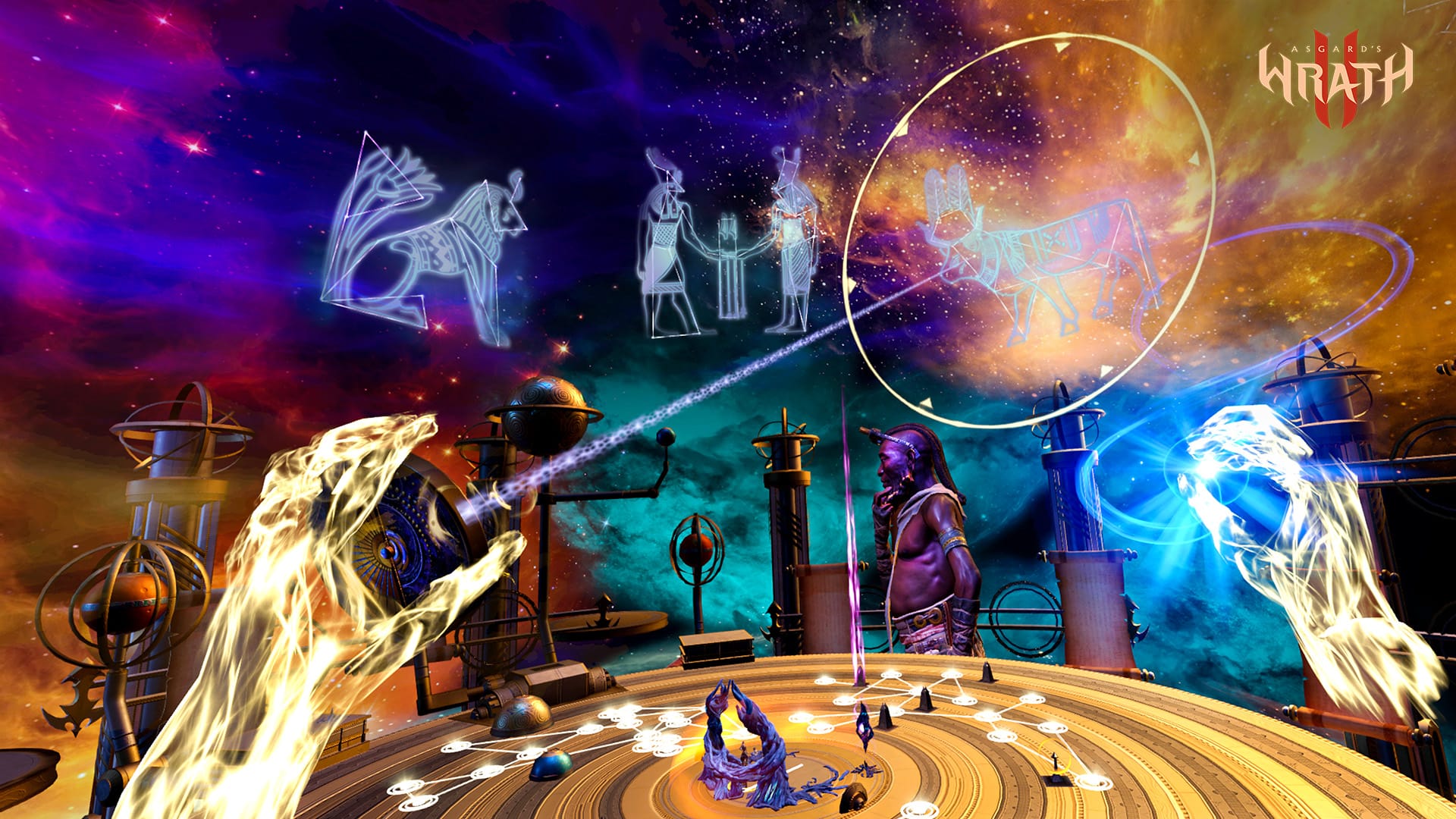
Asgard’s Wrath 2 is available now, bringing the open world fantasy RPG genre to the VR masses.
As Sanzaru Games’ first release post-acquisition, the game stands as Meta’s first big bet on AAA gaming for standalone virtual reality. Leading the player through an epic tale of the gods, it ultimately offers an experience of previously unseen scale on Quest headsets – but at what cost?
Asgard’s Wrath 2 is a follow-up to the 2019 original for PC VR, placing it in an interesting position as Meta’s first big-budget AAA Quest title. It’s a sequel that few were clamoring for, now included free with headset purchase for an entirely different (and standalone) ecosystem. It’s likely that few Quest owners have even heard of the original Asgard’s Wrath, let alone played it.
Platforms: Meta Quest (Review conducted on Quest 3)
Release Date: December 15
Developer: Sanzaru Games
Price: $59.99 (or included free with purchase of Meta Quest 3 headsets until January 27, 2024)
The sequel picks up right where the original left off, but Meta and Sanzaru insist it can be played without prior knowledge or experience. An optional prologue can bring the uninitiated up to speed on the story so far, which ends with the player tricked by the Norse god Loki and trapped in a fabricated tavern from which they must now escape.
As someone who hasn’t played the original, I can’t say that the prologue felt particularly helpful in concisely summarizing such a dense narrative premise. However, that doesn’t really matter – it’s a problem that runs deeper across the entire game, with narrative frequently bogged down by godly lore, name-dropping and endless exposition. The main objective, at least, is clear: find Loki.
So begins an expansive campaign that moves from the sand dunes of Egypt across to the banks of the Nile and to other realms beyond, including many explorable areas. With a high-profile cast of voice actors, some of the most well known gods across Egyptian, Greek and Norse mythology are brought to life in Asgard’s Wrath 2 with stunning animation and cinematic direction.
Godly Scale
The game’s enormous scale, in both a cinematic and structural sense, is conveyed well in the opening sequences. From the get go, it’s clear that the art direction, animation and cinematic framing of Asgard’s Wrath 2 is sublime. Having begun its life as a PC VR title praised for its high-fidelity graphics, the sequel sees Sanzaru transition the franchise to standalone VR hardware – a move that innately limits the upper ceiling of graphic fidelity.
It’s a testament to the studio that Asgard’s Wrath 2 overcomes these limitations to present players with sequences, vistas and environments that play out on a godly scale – literally and figuratively. There are moments in Asgard’s Wrath 2 that blow away the competition – not in terms of fidelity, but grandiosity. The game is still, in its best moments, visually impressive, but it’s the art direction and sense of immense scale that put it a cut above the rest. Instead of honing down into beautiful textures or immense intricacy, the game instead plays into moments that intensely demand and direct your attention. Asgard’s Wrath 2 is incredible at making a spectacle and understands how virtual reality can make those moments more awe-inspiring than they would be on a flatscreen system.
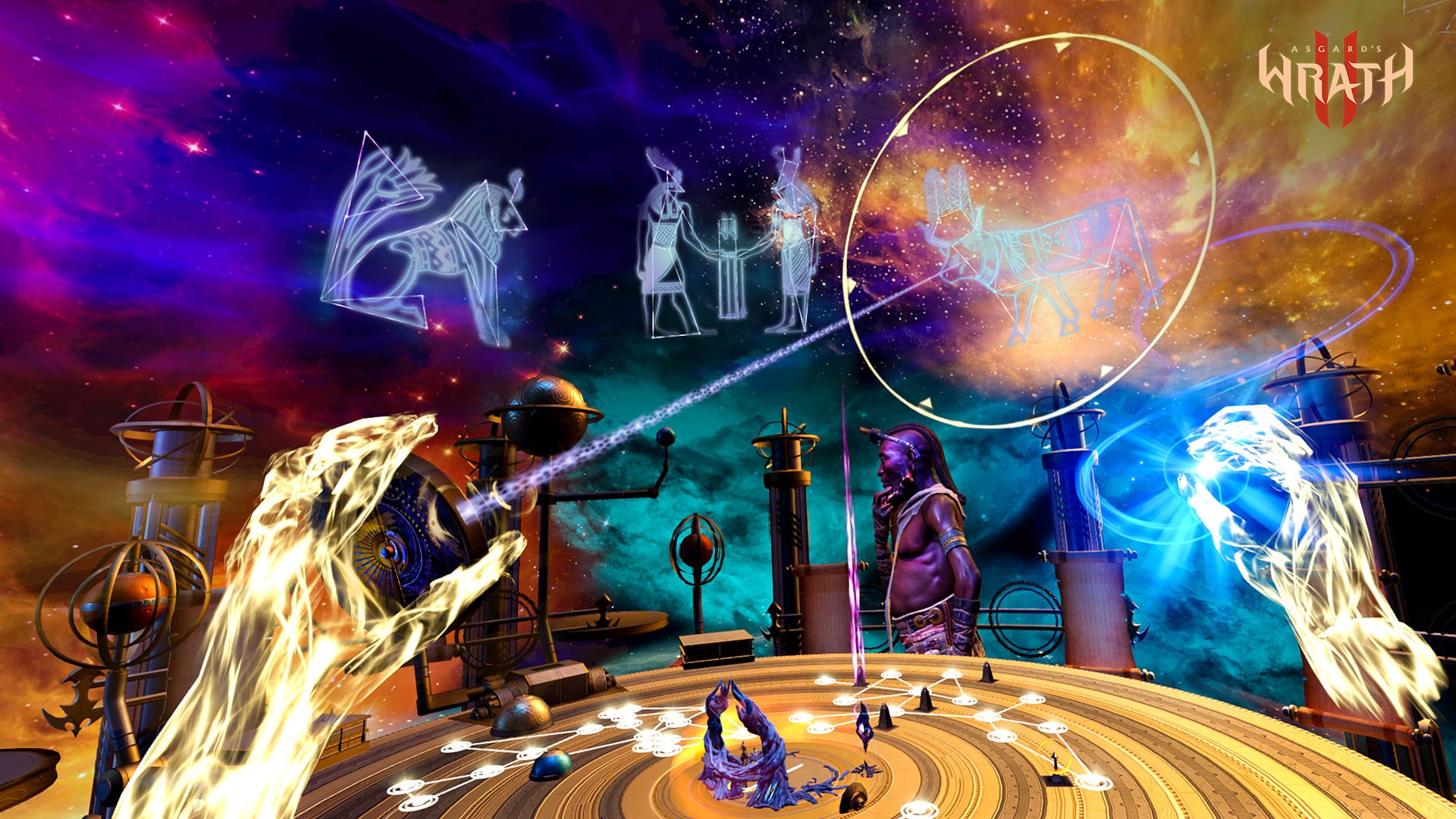
The Art of Performance
Those spectacles are even more impressive given the technical achievement required to pull them off. There are several instances where Sanzaru Games pushes the Quest system to new heights with Asgard’s Wrath 2’s grandeur, often surpassing the already-high ambition of some of the system’s best titles.
Meta told us before launch that the game runs at a fixed resolution on Quest 3 and would dynamically scale between 72Hz and 90Hz. However, there was a “pre-launch issue” with running at 90Hz – a post-launch patch fixes this, now allowing users to toggle 90Hz on permanently on Quest 3. The patch also adds an Enhanced Rendering Features toggle for Quest 3, which will increase the game’s rendering resolution and extend the LOD distance. On Quest 2, Meta tells us that the game runs at 72Hz with dynamic fixed foveated rendering during GPU-heavy areas.
Asgard’s Wrath 2 Gets Its First Quest 3 Upgrades
Asgard’s Wrath 2 now has Quest 3 exclusive settings for 90Hz refresh rate & higher resolution with extended LOD distances.
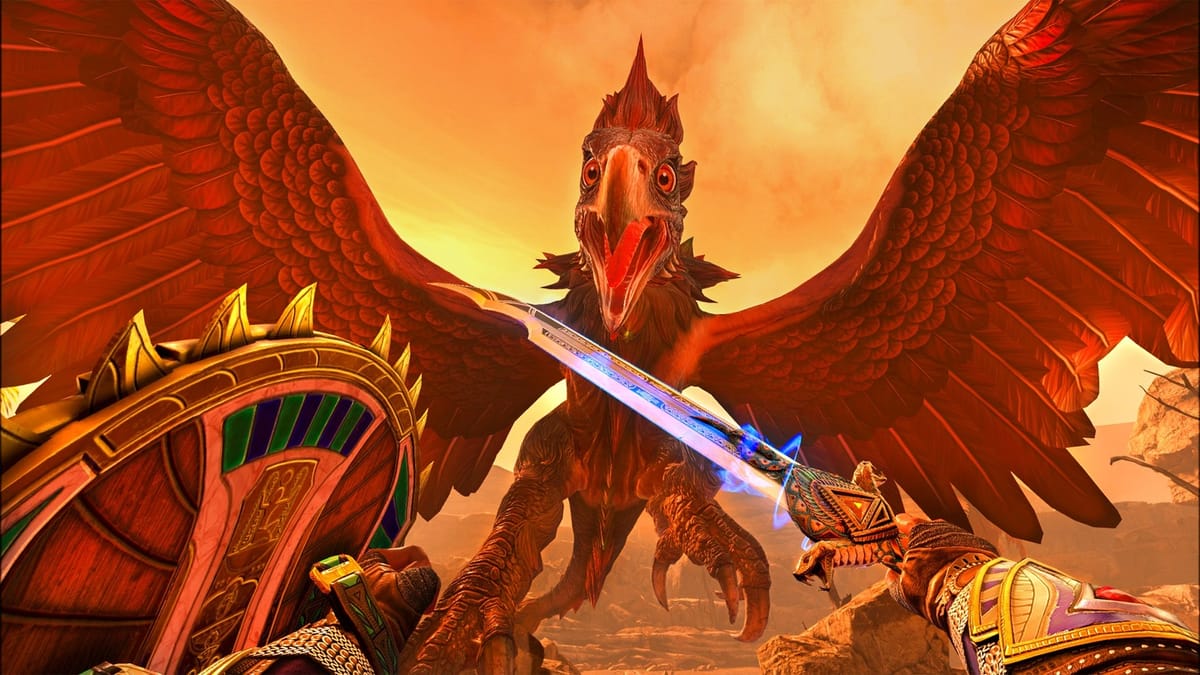
We found performance on Quest 3 to be mostly solid overall, with some hitches and occasional moments of judder. Those will only be noticeable to some, however, and unlikely to affect the playthrough of most.
Besides those two toggles, Asgard’s Wrath 2 does not feature any other specific visual enhancements on Quest 3 at launch. This means that texture quality, lighting, shadows and other parts of the visual presentation will look identical on Quest 2 and Quest 3. This is a huge disappointment, given the game is included free with purchase of the latter headset (which has more than twice the GPU performance of its predecessor) until the end of January.
Oculus Studios says it has “additional enhancement options in mind” for Asgard’s Wrath 2 on Quest 3, but won’t begin work on them until at least the new year.
While playing, it’s pretty clear that the game was designed not just for Quest, but for Quest 2 specifically. Texture quality, environmental density and quality of lighting is all fairly consistent with other Quest 2 titles. The big moments often draw attention away from smaller details – such as muddy textures or simplified object geometry – that reveal where classic Quest 2 cutbacks have been made.
There’s also noticeable pop-in across the entire game, with objects appearing as you move closer towards them and resolving to higher texture quality or increased geometric detail as you approach (though the upcoming patch should improve the latter on Quest 3). It’s mostly forgivable, but seeing goats and other wildlife shimmer into existence only when you’re a few meters away isn’t great for immersion in an exploration-based setting.
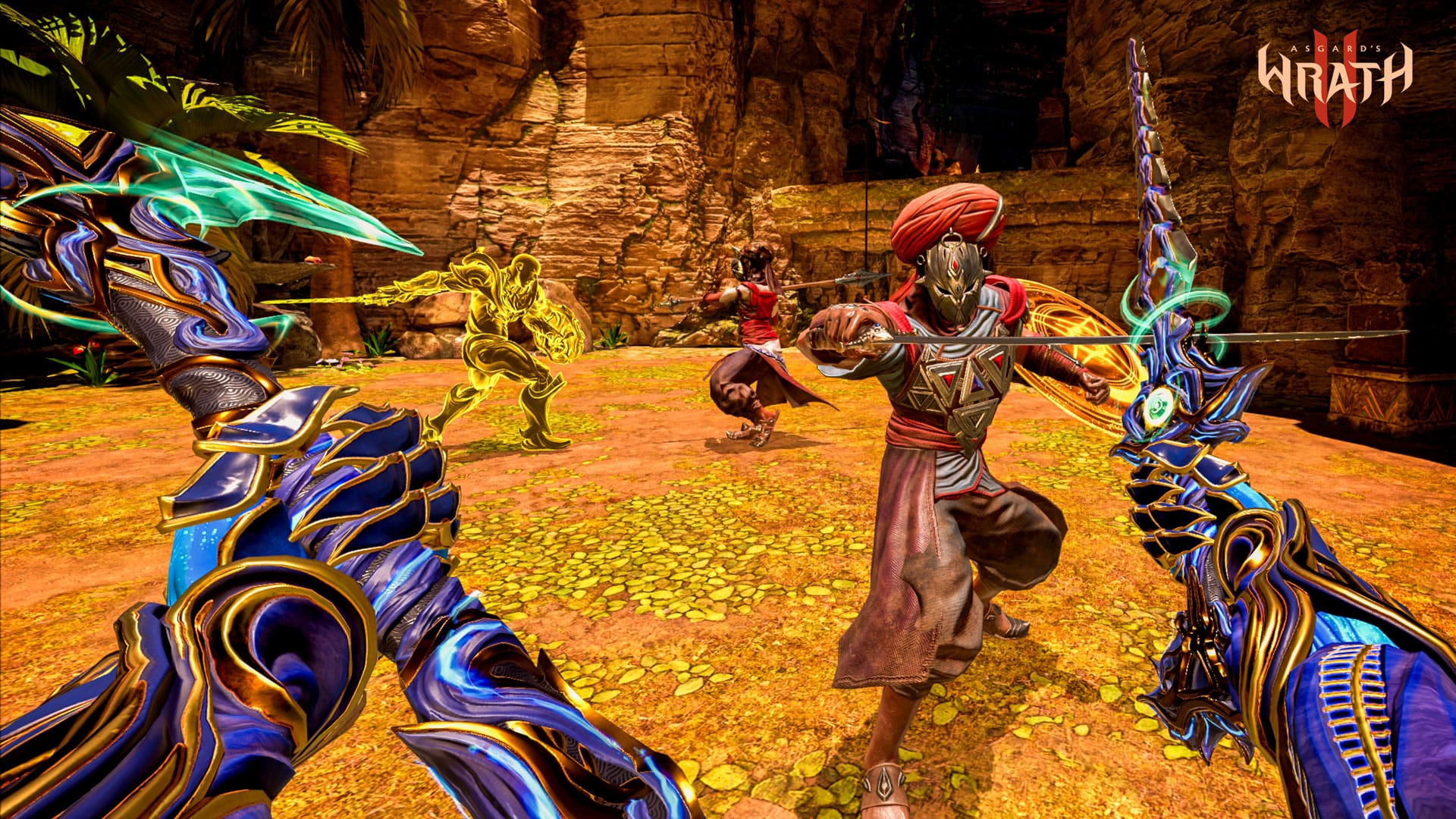
A Whole New (Semi-Open) World
At times, it feels like Asgard’s Wrath 2 is obsessed with convincing you that it’s not a ‘VR game’, but a traditional flatscreen game with the added benefit of being made for virtual reality. Everything about Asgard’s Wrath 2 – from its marketing to its campaign structure to many gameplay systems – seems centered around the concept that it’s just as big, bold and expansive as your favorite flatscreen fantasy RPGs.
Structurally, the game is a semi-open world experience with a main campaign that spans several ‘Sagas’, each of which unlock new playable characters, followers, main missions, explorable areas and side missions. Meta and Sanzaru claim the main campaign is 60 hours long, with a total playtime of 134 hours for ‘completionists’ who cover everything the game has to offer.
Every playthrough will differ, especially depending on how long you spend on the main campaign versus exploration or side quests. In my playthrough, I reached the halfway point of the game’s campaign around the 20 hour mark. After spending time in the open world, it’s hard to envision someone (even a completionist) taking 134 hours to complete everything in Asgard’s Wrath 2, but harder still to envision that being a completely enjoyable experience without arduous repetition.
The game’s implementation of open world elements is fairly lacklustre. The map includes waypoints for side missions and other campaign distractions, but it’s rare that anything piqued my interest enough to naturally divert me while navigating from point A to B.
Unlike the open world mastery of modern flatscreen classics like Red Dead Redemption 2 or Breath of the Wild, emergent storytelling is non-existent or too forced to be enjoyable here. The world of Asgard’s Wrath 2 feels like fairly barren, if often beautiful, set dressing to navigate between missions and waypoints. It almost never feels like a living and breathing civilization, which somewhat undermines the world-ending stakes that the game’s characters so frequently discuss.
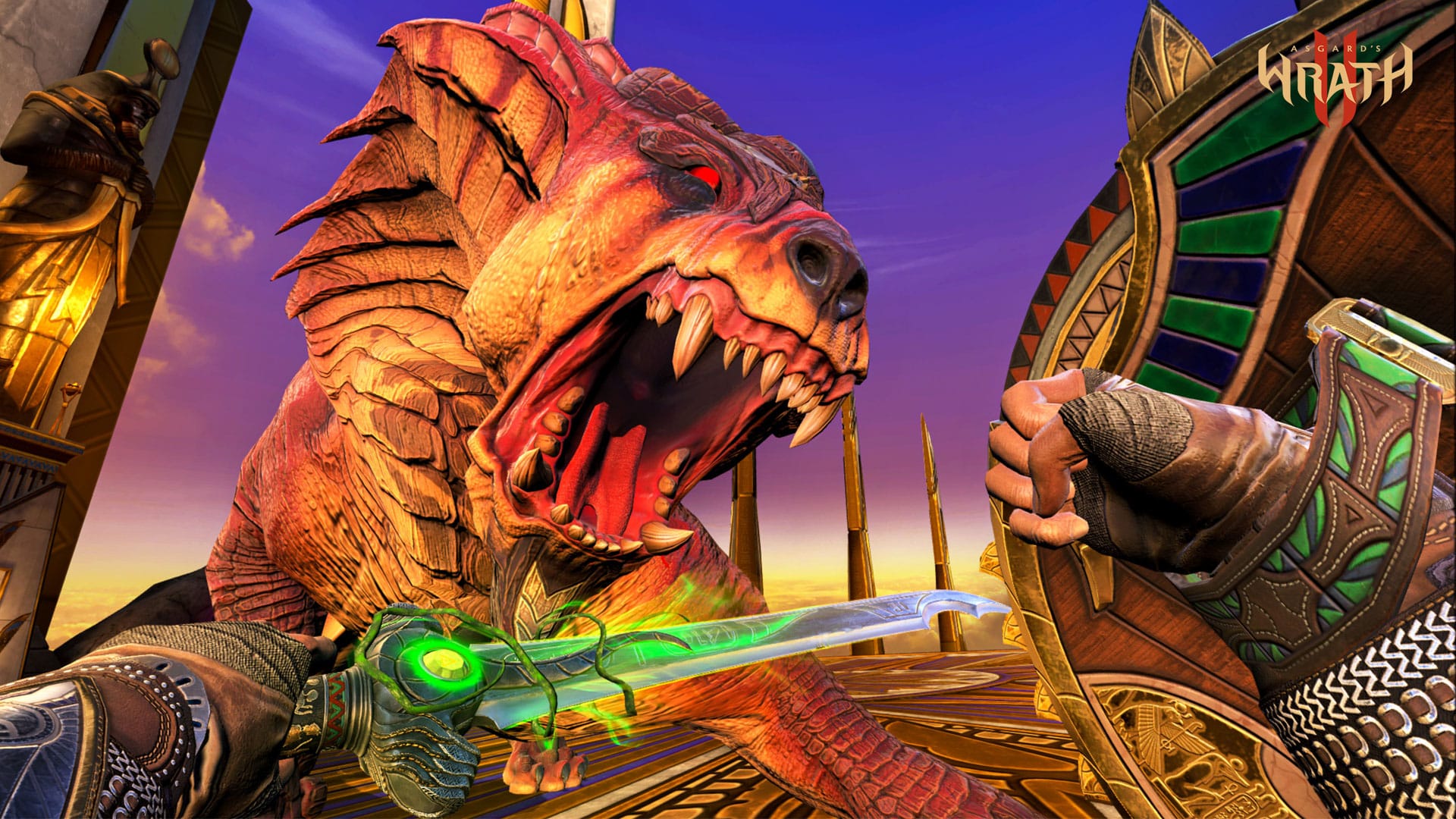
Mortal Combat
Outside of the open world and exploration segments, Asgard’s Wrath 2’s moment-to-moment gameplay is largely designed with a VR-first approach. There are plenty of mechanics that take advantage of the medium in ways that would not be possible – or nearly as engaging – on a flatscreen platform. It’s clear that Sanzaru have a lot of love and passion for the immersive format.
You play as the Cosmic Guardian, a godly figure that possesses a series of mortal characters across the campaign in the multi-realm search to find and defeat Loki. The first mortal you inhabit is Abraxas, kitted out with a sword, shield and axe. Mortals you possess in later sagas include variations on the Abraxas weapons along with completely new tools, such as Cyrene’s bow-like harp.
Combat in Asgard’s Wrath 2 takes on a more user-led approach than the original, allowing the player to engage in attacks as they please without having to first defend or parry. Unfortunately, combat encounters are nonetheless the least engaging part of Asgard’s Wrath 2. The game pursues a melee-based approach, which suffers from the still-unsolvable lack of force feedback with VR motion controllers. There is simply no getting around the fact that when you swing your sword up against an enemy, you will never ‘feel’ the subsequent clash. There is an inherent disconnect between your mind’s expectations, your arm movements and the displayed visuals during melee combat.
This problem isn’t inherent to Asgard’s Wrath 2 – it lies with the limitations of current VR technology. It’s the same reason that Valve shied away from implementing melee crowbar combat in Half-Life: Alyx, opting for gun-based combat instead. The team at Sanzaru are also clearly aware of this problem, because they imbue all weapons with alternate modes of operation that sidestep melee engagement entirely.
All weapons can be thrown at enemies to deal damage as recallable projectiles. With Abraxas, the most damage-effective version of this is his Kratos-like axe, but any weapon will work. Throwing weapons is subsequently a way more satisfying way to approach engagements than melee combat, which easily devolves into slapstick.
There is depth to the combat overall – enemies have a shield/health system, weak points for extra damage, and will intuitively counter attacks to prevent you from spamming one ability – and the extensive skill tree lets you tailor your combat style towards certain weapons or actions. However, the most engaging combat sequences are the big boss battles or similarly bespoke moments. General combat encounters quickly become rote and repetitive.
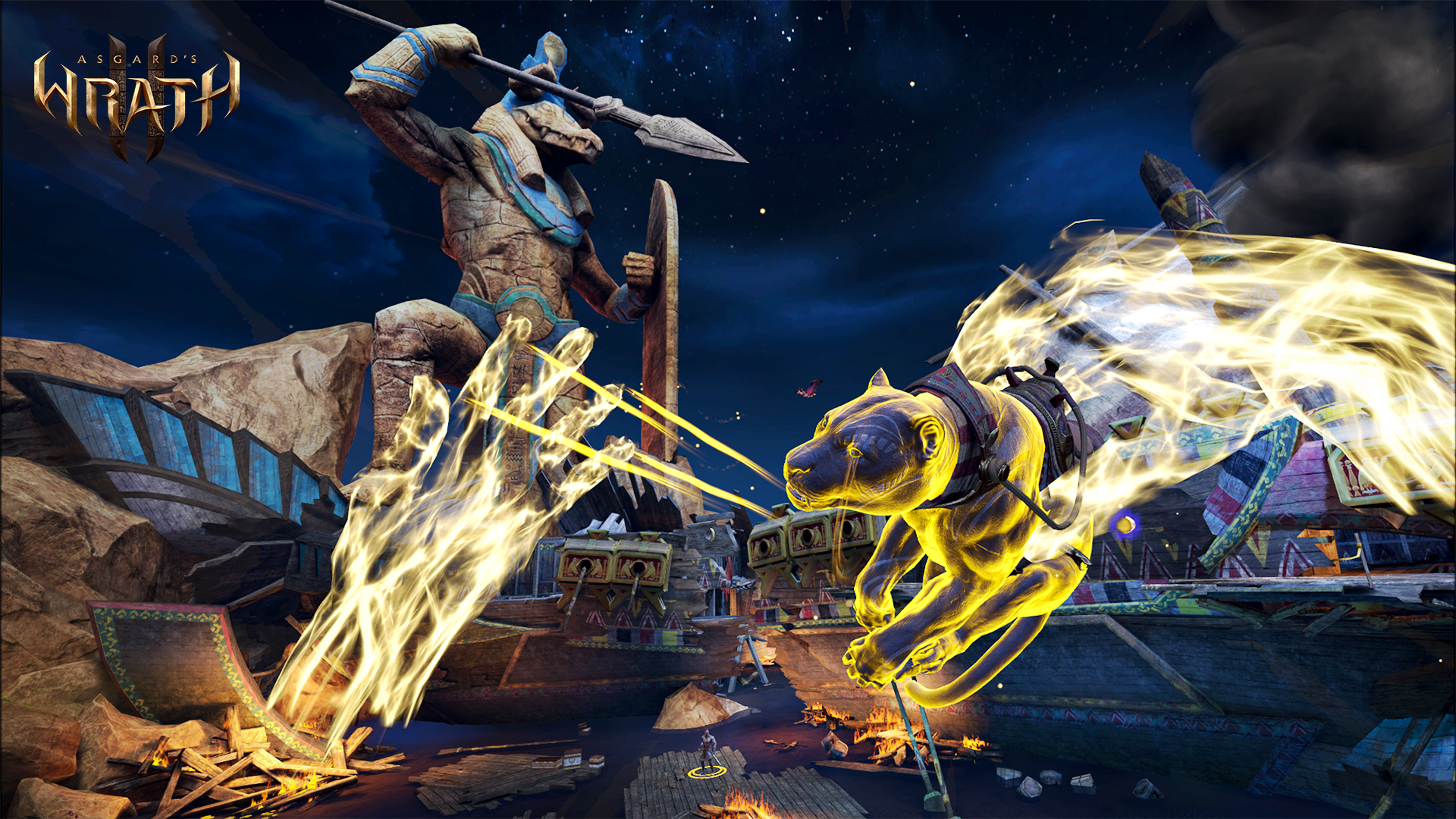
Puzzling Pieces
Most missions in Asgard’s Wrath 2 structurally resemble conventional gaming ‘dungeons’, involving a mix of puzzle scenarios and combat encounters as you navigate through a linear mission environment to retrieve an item or get from point A to point B.
Puzzles often involve using weapons outside of combat to affect the environment or traverse platforming sequences. Thrown weapons can hit elements like faraway buttons, often inducing timed sequences or opening up new areas.
A mid-saga upgrade to Abraxas’ sword includes a grapple-like ability, which allows you to pull yourself from one area to another using set tether points. Likewise, Cyrene’s harp can be used to lure water creatures around areas to solve specific puzzles in later sections of the game.
The God-scale puzzle segments from the original also return in Asgard’s Wrath 2, seeing you dynamically switch between mortal-scale gameplay and a larger god-form that looks down on the environment from above. While playing in god-scale, you can pick up items and reposition parts of the environment to clear a way forward or otherwise affect your options in mortal form. It’s one of the game’s most unique mechanics and remains one of the franchise’s most interesting approaches to puzzling.
Missions frequently combine use of weapons, followers, God-scale gameplay and other environmental elements (such as hooks, chains, levers and pulleys) to create engaging combinations that keeps the gameplay fresh across each saga.
Along the campaign, you’ll also recruit a series of animal followers who can be summoned to fight alongside you or use unique abilities to help solve puzzles, adding new mechanics and increased depth. Followers can also be transformed into mounts to speedily get around the environment during exploration – Subira the panther and Wahka the baboon are great on land, whereas Pa’akhet the falcon opens up aerial traversal while Mereret the hippo helps you navigate the waters of the Nile.
An RPG Structure
Asgard’s Wrath 2 has all the makings of a traditional fantasy RPG structure. Alongside the aforementioned explorable world, side quests, puzzle-ridden dungeons and overall mission structure, there’s most of the other RPG trimmings you would expect: collectables, potions, skill trees, inventory, food, item crafting, treasures, expansive lore, optional dialogue paths, a hub area with merchants offering items and upgrades – the lot. For those who enjoy that level of depth, all of those systems are at your disposal. However, I largely found them superfluous to the core experience. Much of the campaign seems playable without taking advantage of many of them.
It doesn’t help that the menu systems – used for maps, inventory management, quest tracking and more – are all fairly ill-conceived for virtual reality, featuring giant screens that you interact with through pointing a controller-based cursor. It feels miles away from the VR-first menu system used in Glassbreakers or the backpack inventory method used in Saints & Sinners, both of which are designed around physical interactions and therefore far more intuitive.
Asgard’s Wrath 2 Review – Comfort
Asgard’s Wrath 2 uses stick-based smooth locomotion, alongside various automatic movements such as wall running, sliding, grappling and more. There are also sequences featuring slow automatic movement along a set path. The game includes several options to taper the intensity of movement, including options to reduce head shake and movement-related effects.
In our preview, we noted how Asgard’s Wrath 2 did not include traditional implementation of vignette systems for comfort, referred to in-game as ‘tunnelling’. Based on feedback, the game has been updated ahead of launch and now includes traditional vignette integration with adjustable intensity. There’s also options for smooth/snap turning, along with turning angle adjustments.
Even with vignette enabled, Asgard’s Wrath 2 can be an intense experience – those with susceptibility to nausea and motion sickness in VR should, as always, approach with care.
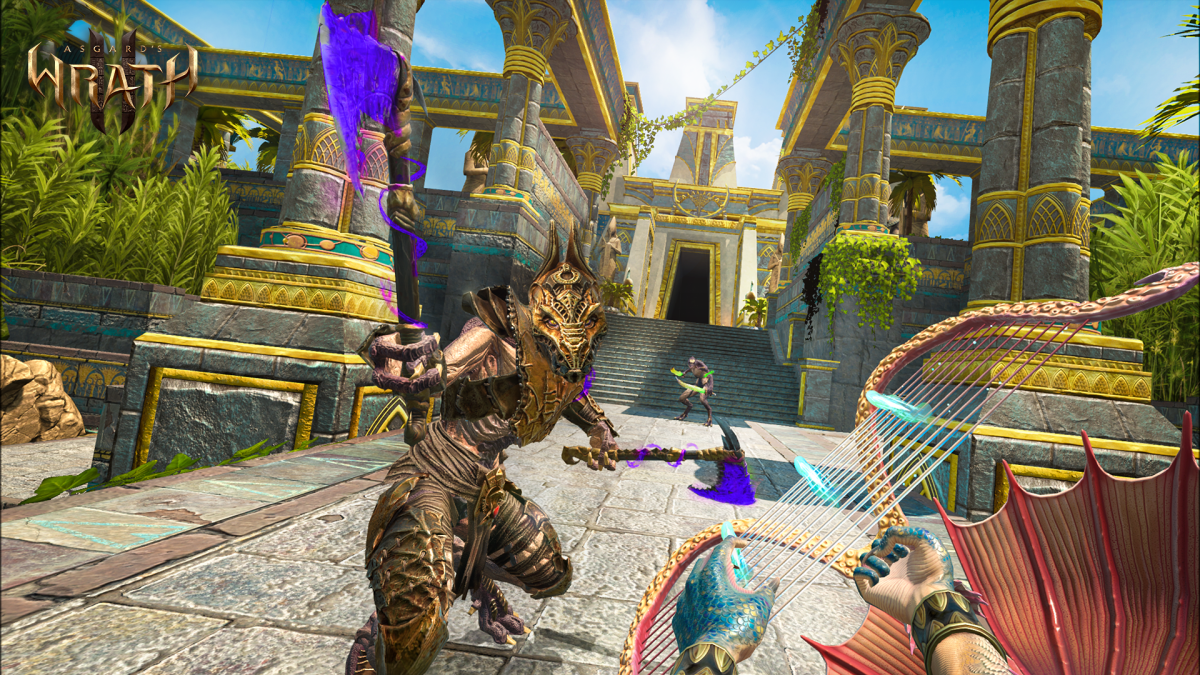
Asgard’s Wrath 2 Review – Final Verdict
Asgard’s Wrath 2 offers Quest players more than ever, on an uncharted scale. There are many incredible moments of bespoke gameplay, expert cinematic direction and animation, and awe-inspiring sequences of truly god-like proportions. However, the game also often curtails to conventions that don’t always serve the medium it’s designed for, with pockets of epic gameplay wrapped around a flatscreen-derivative structure.
Imagine if the chapters in Half-Life: Alyx were interspersed by an ‘open world’ explorable City 17 – repetitive Combine encounters, some lore-based collectables and ‘dungeons’ featuring endless head crabs and multi-tool puzzles, but an otherwise near-deserted city that you have to move across to get to the start of the next campaign missions. That’s often what it feels to play Asgard’s Wrath 2.
There is a solid VR campaign within Asgard’s Wrath 2. It’s just a matter of whether you’re someone who’ll enjoy – or simply put up with – everything else that comes alongside it.

UploadVR uses a 5-Star rating system for our game reviews – you can read a breakdown of each star rating in our review guidelines.
Editor’s note: This review was first published on December 14, 2023 as a review-in-progress. It was updated and republished, including expanded thoughts and a final verdict, on December 20.






